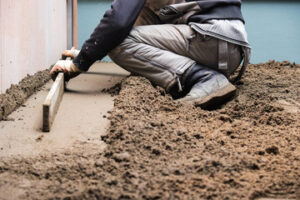How to Spot Foundation Repair Problems
The foundation supports your entire home and protects it from storm damage, so it’s not something you want to ignore. Keeping up with minor repairs can save you time and money and prevent serious issues.
A quick and effective repair is to install a drain tile system to prevent hydrostatic pressure in your soil. This method only takes a few hours, can be done in any weather, and requires no landscaping. Contact Sugar Land Foundation Repair for professional help.
A vertical crack that extends up or down from a foundation wall is a good indicator that the soil beneath your home has shifted. This type of movement can cause significant stress on your home’s foundation walls and, if not corrected in time, lead to severe structural damage to the house.
This type of movement usually results in bulging or bowing walls, which may also develop horizontal cracks as well. The pressure on your foundation from the sagging or bowing walls can be quite considerable, and can even break through a concrete slab. If you see this type of movement, it is essential to contact a professional right away.
The most common reason for a hairline crack in your foundation is that the concrete is settling and curing. This is a normal process, and a few hairline cracks are not necessarily cause for concern unless they get wider than a quarter of an inch. You should also monitor the cracks to ensure that they don’t grow any larger, and you should call a professional if they do.
New construction cracks can also be a sign that the building materials used in the foundation were not properly matched to the load bearing capacity of the soils underneath the footings. In addition, these cracks can often be a symptom of blasting activity near the foundation site. These cracks will often widen quickly, and may need to be addressed with a foundation underpinning solution that includes installing helical tiebacks to anchor the footings into a stable strata of soil. This will help counteract the pressure from the soil pushing on the foundation walls. Filling the cracks with caulking is not a long-term solution, as the cracks will likely reopen with changes in soil moisture and temperature.
Horizontal Cracks
A horizontal crack is a sign that the house has settled into the ground unevenly. It’s fine for homes to settle slightly after they’re built, but it becomes a problem when the settlement isn’t uniform across the foundation. Differential settlement puts tremendous stress on a foundation and can lead to serious structural issues, including horizontal cracks in walls.
All cracks that develop in the foundation should be checked, and if the crack is wider than a quarter-inch, you need to consider professional repair. Those cracks need to be fixed right away, since they could allow water and moisture to leak into the basement or crawl space. This can cause mold growth, wood rot, and other problems that necessitate professional repairs.
The best way to fix a horizontal crack is to inject epoxy or polyurethane foam into it. However, this is only a temporary solution. The crack will likely reappear in the future, so it’s important to look for a permanent solution.
One preventative measure is to clean up any dirt or debris that might be collecting in the crack. This will also help to keep the moisture in the soil at a minimum.
If you have a new home and notice a horizontal crack, check with your builder to see if it’s covered by the warranty. If not, it might be time to contact a contractor for more permanent repairs.
A stair-step crack that looks like a set of steps is usually caused by expansion or shrinkage of the concrete. This can happen because of poor construction, but it might also be caused by a change in the ground’s water content due to rain or other factors.
Generally, this type of crack isn’t very serious and isn’t something to worry about, unless it widens or gets longer over time. In some cases, a French drain can help to solve the issue by draining excess water from the yard. Other times, a waterproofing system in the basement or crawl space might be needed to prevent water infiltration. This can be expensive, but it’s usually less costly than a full foundation replacement.
Stair-Step Cracks
Often found near doors and windows, stair-step cracks are a sure sign of foundation settlement or movement. This type of cracking results from stresses created by a combination of forces of restraint holding parts of the wall in place and forces trying to move it. This type of cracking is especially common in homes with clay soils, as they tend to expand and contract more than other types of soil. Stair-step cracks also appear more frequently in brick houses with framed-out windows and doors, since these areas are weaker points of the house.
If a stair-step crack forms along a corner, it typically indicates that the foundation is moving in a diagonal direction. To determine the exact cause, a professional assessment is recommended. Stair-step cracks that occur in the middle of a wall are usually caused by thermal expansion and shrinkage, while cracks at the corners may indicate settling of the foundation or soil displacement around the house.
Stair-step cracks that form at the top of a wall are generally caused by a combination of stresses from ground movements and moisture. These are the most serious type of cracks in a brick foundation, and should be treated with the same urgency as horizontal or vertical foundation cracks. Attempting to repair these types of cracks by sealing them is not recommended as it will likely result in further damage and potentially lead to structural instability.
In the rare case that a new home develops stair-step cracks, it is generally due to concrete curing and drying. This is particularly true in new builds with high humidity and warm weather, and can be corrected by keeping gutters clean and grading the yard to divert water away from the house.
Stair-step cracks in a brick foundation can be a significant problem and should be addressed by a professional mason as soon as possible. In addition, they should be inspected regularly to ensure that they do not worsen. Ideally, the source of the movement should be identified and eliminated to prevent further damage to the foundation. For more information about this, please visit the wikiHow page on how to fix stair-step cracks.
Diagonal Cracks
Diagonal cracks are a sign of structural problems that need to be investigated by a foundation repair specialist. These cracks run a slanting angle (up to 70 degrees) from one end of the wall to the other and can be wider on one side than the other. They appear when a house is built on shrinkable clay soil, such as black cotton soil, or has a shallow foundation.
They are most often caused by a shifting or settling of the foundation. If the cracks are not addressed, they may continue to grow and eventually lead to a collapsed foundation. It is very important to identify the cause of the cracking and have it repaired as soon as possible.
Although diagonal cracks are not as serious as horizontal ones, they still indicate that the foundation has moved, and this needs to be rectified immediately. This can be done by filling in the cracks with a special concrete, usually with a polyurethane or epoxy injection.
The size of the crack is also a crucial factor to consider. A crack that is less than 1/10 inch wide can be ignored, but if it continues to get wider you should contact a professional for an inspection.
Larger cracks, especially those that are centered around doors and windows, are usually a sign of major structural movements and should be investigated by a professional right away. They could also be a result of an illegal basement conversion, or even neighboring property excavation work.

